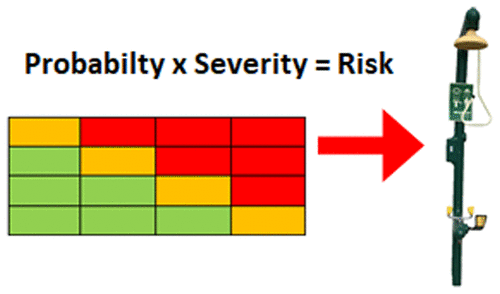当前位置:
X-MOL 学术
›
ACS Chem. Health Saf.
›
论文详情
Our official English website, www.x-mol.net, welcomes your
feedback! (Note: you will need to create a separate account there.)
Development and Implementation of a Clinical Eyewash and Safety Shower Risk Assessment Process in an Academic Medical Center
ACS Chemical Health & Safety ( IF 2.9 ) Pub Date : 2019-11-13 , DOI: 10.1021/acs.chas.9b00003 William John Pate 1 , Jeremy Wilke 1
ACS Chemical Health & Safety ( IF 2.9 ) Pub Date : 2019-11-13 , DOI: 10.1021/acs.chas.9b00003 William John Pate 1 , Jeremy Wilke 1
Affiliation

|
The Occupational Safety & Health Administration requires emergency eyewashes and showers to be made available to employees in locations where employees’ eyes or body may be exposed to injuriously corrosive materials, as well as in areas where employees may be splashed by solutions containing 0.1% or more of formaldehyde [Occupational Safety and Health Administration: Formaldehyde, standard 1910.1048; Medical Services and First Aid, standard 1910.151]. These requirements are also enforced by accreditation organizations such as The Joint Commission. In an academic health care environment, the clinical use of chemicals and pharmaceuticals can result in potential exposure to substances that require the presence of an eyewash station or safety shower. In the clinical environment seen in hospitals, the literal and direct application of these OSHA standards would require eyewash stations be located on almost every sink. Such an application would result in significant and unnecessary costs to install, maintain, and test eyewash stations. In order to develop an effective eyewash program that ensures employee safety while minimizing unnecessary use of resources, a standardized eyewash & safety shower risk assessment process was developed and implemented across a multihospital health system in both the inpatient hospital setting as well as across 80+ outpatient clinics. Initial feedback from the program included consistent, documented decisions for eyewash and safety shower installation and removal as well as favorable results from a Joint Commission accreditation survey.
中文翻译:

在学术医疗中心开发和实施临床洗眼和安全淋浴风险评估程序
职业安全与健康管理局要求在员工的眼睛或身体可能暴露于有害腐蚀性物质的地方以及员工可能被含有0.1%或更高浓度的溶液溅出的区域中提供紧急洗眼器和淋浴器给员工。甲醛[职业安全与健康管理局:甲醛,标准1910.1048;医疗服务和急救,标准1910.151]。这些要求也由联合委员会等认可组织强制执行。在学术保健环境中,化学药品和药物的临床使用可能导致潜在接触需要洗眼器或安全淋浴的物质。在医院所见的临床环境中,这些OSHA标准的文字和直接应用将要求在几乎每个水槽上都安装洗眼器。这样的应用将导致安装,维护和测试洗眼站的大量不必要的成本。为了制定有效的洗眼程序,在确保员工安全的同时最大程度地减少不必要的资源使用,制定并在住院医院环境以及80多个门诊患者的多医院卫生系统中实施了标准化的洗眼和安全淋浴风险评估程序。诊所。该计划的初步反馈包括有关洗眼器和安全淋浴器安装和拆卸的一致记录的决定,以及联合委员会认可调查的良好结果。这样的应用将导致安装,维护和测试洗眼站的大量不必要的成本。为了制定有效的洗眼程序,在确保员工安全的同时最大程度地减少不必要的资源使用,制定并在住院医院环境以及80多个门诊患者的多医院卫生系统中实施了标准化的洗眼和安全淋浴风险评估程序。诊所。该计划的初步反馈包括有关洗眼器和安全淋浴器安装和拆卸的一致记录的决定,以及联合委员会认可调查的良好结果。这样的应用将导致安装,维护和测试洗眼站的大量不必要的成本。为了制定有效的洗眼程序,在确保员工安全的同时最大程度地减少不必要的资源使用,制定并在住院医院环境以及80多个门诊患者的多医院卫生系统中实施了标准化的洗眼和安全淋浴风险评估程序。诊所。该计划的初步反馈包括有关洗眼器和安全淋浴器安装和拆卸的一致记录的决定,以及联合委员会认可调查的良好结果。为了制定有效的洗眼程序,在确保员工安全的同时最大程度地减少不必要的资源使用,制定并在住院医院环境以及80多个门诊患者的多医院卫生系统中实施了标准化的洗眼和安全淋浴风险评估程序。诊所。该计划的初步反馈包括有关洗眼器和安全淋浴器安装和拆卸的一致记录的决定,以及联合委员会认可调查的良好结果。为了制定有效的洗眼程序,在确保员工安全的同时最大程度地减少不必要的资源使用,制定并在住院医院环境以及80多个门诊患者的多医院卫生系统中实施了标准化的洗眼和安全淋浴风险评估程序。诊所。该计划的初步反馈包括有关洗眼器和安全淋浴器安装和拆卸的一致记录的决定,以及联合委员会认可调查的良好结果。
更新日期:2019-12-19
中文翻译:

在学术医疗中心开发和实施临床洗眼和安全淋浴风险评估程序
职业安全与健康管理局要求在员工的眼睛或身体可能暴露于有害腐蚀性物质的地方以及员工可能被含有0.1%或更高浓度的溶液溅出的区域中提供紧急洗眼器和淋浴器给员工。甲醛[职业安全与健康管理局:甲醛,标准1910.1048;医疗服务和急救,标准1910.151]。这些要求也由联合委员会等认可组织强制执行。在学术保健环境中,化学药品和药物的临床使用可能导致潜在接触需要洗眼器或安全淋浴的物质。在医院所见的临床环境中,这些OSHA标准的文字和直接应用将要求在几乎每个水槽上都安装洗眼器。这样的应用将导致安装,维护和测试洗眼站的大量不必要的成本。为了制定有效的洗眼程序,在确保员工安全的同时最大程度地减少不必要的资源使用,制定并在住院医院环境以及80多个门诊患者的多医院卫生系统中实施了标准化的洗眼和安全淋浴风险评估程序。诊所。该计划的初步反馈包括有关洗眼器和安全淋浴器安装和拆卸的一致记录的决定,以及联合委员会认可调查的良好结果。这样的应用将导致安装,维护和测试洗眼站的大量不必要的成本。为了制定有效的洗眼程序,在确保员工安全的同时最大程度地减少不必要的资源使用,制定并在住院医院环境以及80多个门诊患者的多医院卫生系统中实施了标准化的洗眼和安全淋浴风险评估程序。诊所。该计划的初步反馈包括有关洗眼器和安全淋浴器安装和拆卸的一致记录的决定,以及联合委员会认可调查的良好结果。这样的应用将导致安装,维护和测试洗眼站的大量不必要的成本。为了制定有效的洗眼程序,在确保员工安全的同时最大程度地减少不必要的资源使用,制定并在住院医院环境以及80多个门诊患者的多医院卫生系统中实施了标准化的洗眼和安全淋浴风险评估程序。诊所。该计划的初步反馈包括有关洗眼器和安全淋浴器安装和拆卸的一致记录的决定,以及联合委员会认可调查的良好结果。为了制定有效的洗眼程序,在确保员工安全的同时最大程度地减少不必要的资源使用,制定并在住院医院环境以及80多个门诊患者的多医院卫生系统中实施了标准化的洗眼和安全淋浴风险评估程序。诊所。该计划的初步反馈包括有关洗眼器和安全淋浴器安装和拆卸的一致记录的决定,以及联合委员会认可调查的良好结果。为了制定有效的洗眼程序,在确保员工安全的同时最大程度地减少不必要的资源使用,制定并在住院医院环境以及80多个门诊患者的多医院卫生系统中实施了标准化的洗眼和安全淋浴风险评估程序。诊所。该计划的初步反馈包括有关洗眼器和安全淋浴器安装和拆卸的一致记录的决定,以及联合委员会认可调查的良好结果。











































 京公网安备 11010802027423号
京公网安备 11010802027423号